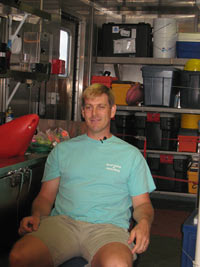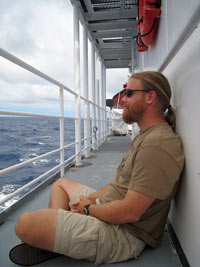|
You
are here: /main/research
expeditions/August/September 2007/Rob Toonen Team
Interview
with Dr. Rob Toonen and his inertebrate collections
team
by Carlie Wiener
Click
here to see where the Hi'ialakai is now.
Click
here to see current data from the ship.
 |
Dr. Rob Toonen – Principal Investigator,
HIMB
Biography
Dr. Toonen first gained interest in marine biology
back in his childhood. Growing up in Canada, his
father owned a pet store where he was infatuated
with the aquarium animals. This is Dr. Toonen’s
first trip to the Monument even though he has been
actively doing research about the species found in
the Northwestern Hawaiian Islands for the past four
years. |
Role on the research trip
Dr. Toonen will be leading the invertebrate collections
on this trip. He is fascinated by the amazing habitat and
hopes that his findings will help to conserve the area
for future generations. He believes that in order to be
a good steward we have to have a good understanding of
how to conserve the area.
Favorite part about being at sea
Dr. Toonen loves being able to leave behind the
day to day activities and experience the marine habitats
he works with first hand. Being away from the everyday
pressures and in the natural environment reminds Dr. Toonen
of why he was first interested in the ocean.
What they are doing
There are three separate issues which the team will be addressing
in their research. Invasive species are one of their concerns
relating to movement patterns, where they came from and
how to prevent their spread. Another aspect of the research
will address life history of coral reef organisms both
from an ecology and larval biology standpoint. This means,
that scientists will look at individual coral growth and
reproduction. Lastly, the group will also explore population
genetics as it relates to the number of species exchanged
through the Monument both as adults and offspring.
The group will be looking at 30 different reef invertebrates
such as sea stars, cucumbers and slugs. Some corals will
also be examined, in hopes of understanding the community
links. To begin, the samples are statistically analyzed for
the minimum amount needed to sample in order to minimize
impact. Based on previous knowledge, the researchers will
target areas where they are likely to find the species that
they are looking for. Depending on the invertabrate, they
can gather samples right under the water such as the case
with hermit crabs. Other species such as sea cucumbers are
brought to the surface and a small skin sample is taken for
DNA analysis. The species are put back into the ocean exactly
where they are found. In addition, the scientists hope to
develop a spatial threat assessment map. This is done by
overlaying threats such as pollution, global warming, ship
impacts, research, coral disease, etc, onto layers of a map
highlighting reef structure. By emphasize areas with the
greatest impact it is hoped that the map will provide an
idea of what sites to focus conservation on.

Dr. Rob Toonen's team planning a day's work. Credit
Carlie Wiener
What they hope to find
Right now, one of the pressing questions is how
related the Hawaiian archipelago is. It is hoped that by
continuing this research in conjunction with other projects,
the connectivity of the Monument to the main Hawaiian Islands
will become known. Being able to understand connections
will help scientists get a better understanding of how
the individual marine communities rely on each other. Scientists
need to know if preserving the reefs in the Monument will
provide recruitment species for the main Hawaiian Islands.
How the science helps to inform Management
The Monument is a vast area, with a huge spatial
scale including numerous scattered islands and atolls.
It is essential to know how connected they are to each
other, or if they stand alone. This information is important
when looking at disaster prevention. How likely one area
will substitute another or how the chain as a whole will
relate to local effects is important. This survey work
is not only being carried out in the Northwestern Hawaiian
Islands but in the main Hawaiian Islands, Johnston Atoll,
and other close pacific regions. This will help scientists
get a greater grasp on pathways and connections for previous
and new species. If they can figure out how species are
introduced then stronger management towards invasive species
can be formed. Understanding population genetics is essential
to properly conserve organisms in such an isolated archipelago.
It is crucial to understand how the system interacts with
itself.
Derek Smith – HIMB
 |
Biography
Derek grew up by the ocean in sunny California. He
has always wanted a career in marine biology, and
gets stir crazy if he is not close to an ocean
at all times. This is Derek’s first trip
to the Monument but has participated in other research
expeditions in California and Florida. He currently
works at Hawaii Institute of Marine Biology as
a marine safety officer overseeing both the diving
and boating operations. He enjoys his position
as he gets to support numerous science projects
giving him an opportunity to dive and work with
many people. His interests lie in invertebrate
biology, particularly sea hares. In fact, he is
very proud of his newly found discovery of sea
hares in Kaneohe Bay. He hopes to begin his PhD
next year.
|
Role on the research trip
Derek will be assisting Dr. Rob Toonen in the collection
of marine invertebrates. He is excited to be on
this expedition and hopes to discover new invertebrate
species. He is very interested in why certain species are
located at one reef and not found at another similar location.
Derek finds hope for the oceans through being able to see
one of the last pristine, untouched areas. Without human
influence, Derek hopes to find a greater abundance and
diversity of invertebrate species.
Favorite part about being at sea
No concrete, no civilization.
Jon Puritz – HIMB
 |
Biography
Since childhood Jon has been an avid fan of the ocean. To him the ocean represents
a big mystery, something that encouraged him to pursue sciences. Jon came
out to Hawaii to work with Dr. Rob Toonen on his PhD. Jon is interested in
looking at bat sea stars life history and population connectivity. He is
also fascinated by anthropogenic effects on the bat sea stars. Jon’s
work is unique as he is collaborating with other academic institutions globally
including University of California Davis, Simon Fraser University in Canada,
and University of Sydney in Australia. |
Role on the research trip
This is Jon’s first time out on the ship
and to the Monument. He will be assisting Dr. Rob Toonen
in the collection of marine invertebrates. Jon is
very interested in the differences in population connectivity
between the outer and inner atolls. Jon enjoys working
with invertebrates because they are usually not thought
about and are challenging to work with. He hopes to gather
a suite of invertebrates across the Hawaiian Archipelago,
filling out the sample collections and possibly discovering
a new species.
Favorite part about being at sea
Always being able to feel the ocean, and know that it is
constantly there.
Click
here for maps of the region
|